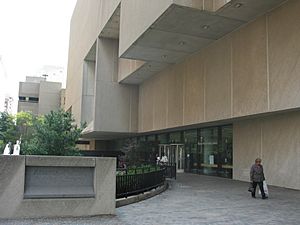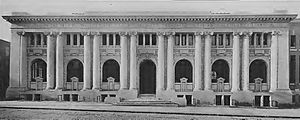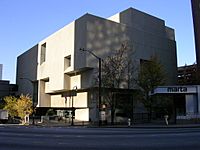Atlanta–Fulton Public Library System facts for kids
The Atlanta–Fulton Public Library System is a group of public libraries that serve the City of Atlanta and Fulton County in Georgia, USA. Fulton County manages this library system. It includes the main Central Library in Downtown Atlanta, which is the system's main office. It also has the Auburn Avenue Research Library on African American Culture and History, plus 33 other branch libraries.
Contents
History of the Library System
How the Library Started
The library system began with the Young Men's Library Association (YMLA) in 1867. This was a library where you paid to be a member. Only members could borrow books. At first, only white men could join. In 1873, white women were also allowed to become members. The YMLA was the main library for Atlanta for many years. In the 1890s, the YMLA, along with a famous businessman named Andrew Carnegie, and the City of Atlanta, started planning a new public library.
The Carnegie Library
On March 4, 1902, the first true public library opened. It was called the Carnegie Library. It was built where the current Central Library stands today. When it first opened, only some parts of the building were ready. The Carnegie Library was the main library for most of the 20th century. It was updated in 1950 and again in 1966. In 1950, the system was renamed the Atlanta Public Library. The Carnegie Library building was taken down in 1977. This made space for the new Central Library. However, parts of the old building were saved. They were used to create the Carnegie Education Pavilion. This monument celebrates higher education in Atlanta.
Growing the Library System
The Carnegie Library was very popular. Just one year after it opened, Andrew Carnegie offered more money. He wanted to help open branch libraries. In 1906, he offered $30,000 for two new branches. The city had to provide the land and ongoing financial support. The Anne Wallace Library opened in 1909. It was named after the first librarian of the Carnegie Library. Many more branch libraries opened in the following years. The Ragsdale branch opened in 1912. The Uncle Remus Branch opened in 1913. By 1924, the library system had eight branches. By 1967, it had 19 branches. Today, the system has grown to 34 branches.
City and County Working Together
For many years, the library only served people living in Atlanta. This meant Fulton County residents outside the city did not have library services. In 1935, the City of Atlanta and Fulton County made an agreement. They used money from the Works Progress Administration and the city. This allowed library services to be offered throughout the whole county. In 1982, a new law allowed the city to give control of the library system to the county. In 1983, Fulton County took over. To show this change, the system was renamed the Atlanta–Fulton Public Library System.
Access for All in the Library
When the Carnegie Library opened in 1902, Black people were not allowed to use it. An activist named W. E. B. Du Bois tried to change this. He wanted Black people to have equal access or at least their own branch. But the library board said no. Andrew Carnegie had offered money for a Black branch library. However, this money was not used until 1921. That year, Tommie Dora Barker opened the Auburn Avenue Branch Library. This was the first branch library for Black people. It was located in the Sweet Auburn neighborhood. During the time of segregation, two other libraries were opened for Black residents. In 1959, Irene Dobbs Jackson asked for a library card for the main library. After much discussion, the library board voted. On May 19, 1959, they decided to allow Black people full access to the library. Between 1966 and 1973, the library staff also became desegregated.
Future Plans for Libraries
In 2008, voters in Fulton County approved a plan to spend $275 million on libraries. This money is for fixing up old libraries and building new ones. The plan includes building eight new libraries. It also includes making two libraries bigger. And 23 branch libraries will be renovated. Five large libraries will be built in different areas. These new libraries will replace smaller ones or be completely new. A new library will also be built in Palmetto/Chattahoochee Hill County. Two more new libraries will be built in Southeast Atlanta and East Roswell. The Southeast Atlanta library will replace three smaller branches. The plan also set aside money to build a new, very large central library. Finally, the Auburn Avenue Research Library and the South Fulton branch library will be expanded.
The Central Library
The Central Library in Downtown Atlanta is the main office for the library system. It was finished in 1980. This building was the last one designed by Marcel Breuer. He was a famous architect from the Bauhaus movement. The building has a style called "Brutalist" architecture. Experts say it is a "masterpiece." It is similar to the Met Breuer museum building in New York. Breuer could not attend the opening ceremony on May 25, 1980. He passed away a year later.
The idea for the design started in 1969. But the contract for Breuer was not given until 1976. This was because of disagreements about the money needed to build the library. Construction began in 1977. When it was finished in 1980, it had a 300-seat theater. It also had six floors of library space and a restaurant. The building was designed to hold 1,000 users and 1 million books. It is made of a steel frame and concrete. The outside has special concrete panels. These panels were treated to give them texture. Concrete was chosen because it was good for creating the unique shapes of the windows. The second, third, and fourth floors are connected by a large concrete staircase.
Since 1980, some parts of the building have worn down. The theater closed in the mid-1990s because of a water leak. But it has since been fixed. The restaurant was popular at first but closed in the late 1990s. Some people in Atlanta do not fully appreciate the Brutalist style. In 2002, the system spent $5 million to update the building. They added new carpets and more colorful walls. A full renovation would have cost much more. It was unclear what would happen to the Breuer building for a while. However, efforts by artist Max Eternity helped create new interest in the building. In 2010, it was listed as one of the "Most Endangered Sites" in the world. In July 2016, the Fulton County Board of Commissioners voted. They decided not to tear down the building.
Library Branches
- Adams Park Branch
- Adamsville–Collier Heights Branch
- Alpharetta Branch
- Auburn Avenue Research Library
- Buckhead Branch
- Cascade Branch
- Cleveland Avenue Branch
- College Park Branch
- Dogwood Branch
- East Atlanta Branch
- East Point Branch
- East Roswell Branch
- Fairburn Branch
- Gladys S. Dennard Library at South Fulton
- Hapeville Branch
- Kirkwood Branch
- Louise Watley Library at Southeast Atlanta
- Martin Luther King Jr., Branch
- Mechanicsville Branch
- Metropolitan Branch
- Milton Branch
- Northeast/Spruill Oaks Branch
- Northside Branch
- Northwest Branch at Scotts Crossing
- Ocee Branch
- Palmetto Branch
- Peachtree Branch
- Ponce de Leon Branch
- Roswell Branch
- Sandy Springs Branch
- South Fulton Branch
- Southeast Atlanta Branch
- Washington Park Branch
- West End Branch
- Wolf Creek Branch
See Also
- West Georgia Regional Library
- Cobb County Public Library System
- Sequoyah Regional Library System
- Forsyth County Public Library
- Gwinnett County Public Library
- DeKalb County Public Library
- Clayton County Library System
- Flint River Regional Library System
- Coweta Public Library System
Images for kids






